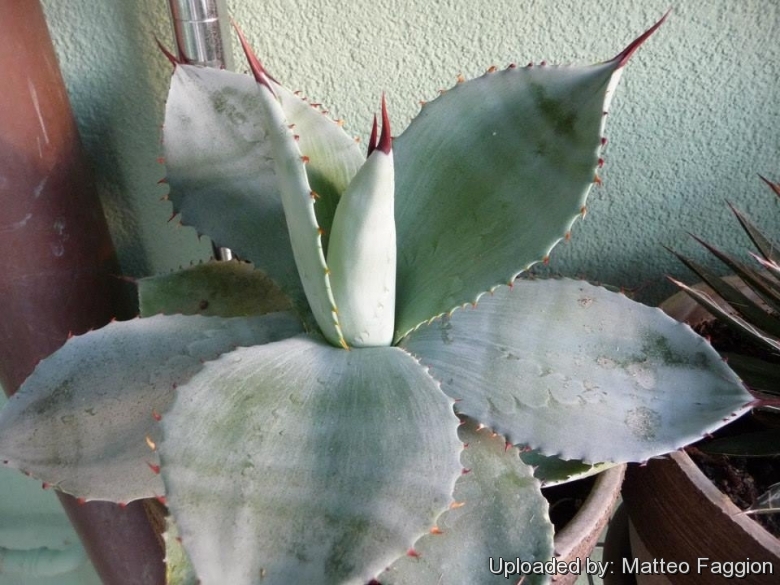= Agave seemanniana subs. pygmaea (Gentry) B.Ullrich
Brit. Cact. Succ. J. 10(1): 27. 1992.
Accepted Scientific Name: Agave seemanniana Jacobi
Abh. Schles. Ges. Vaterl. Cult., Abth. Naturwiss. (1869) 154.

Agave pygmae (Agave seemanniana subs. pygmaea) Photo by: Matteo Faggion
Origin and Habitat: Type Locality: Mexico, Chiapas, about 45 km North of Mexico-Guatemala border along the Pan-American highway (route 190), South of Comitas.
Altitude: About 1000 metres above sea level.
Habitat: It grows on arid white limestone wall.
Synonyms:
See all synonyms of Agave seemanniana
back
Accepted name in llifle Database:Agave seemanniana JacobiAbh. Schles. Ges. Vaterl. Cult., Abth. Naturwiss. (1869) 154.Synonymy: 10
back
Description: Agave pygmaeaSN|554]]SN|552]] (originally described as: pygmae) is a dwarf agave that often develops rosettes with some offsets. It is part of the variable complex of Agave seemanniana and might merely be a depauperate form, a consequence of its arid, limestone habitat.
Rosettes: Rarely exceeding 30 cm in diameter.
Leaves: 12-28 cm long, glaucous or grey-green leaves that are usually quite flat and conspicuously narrowed at the base.
Flowers: Only 32-35 mm long, compared with 47-63 mm for Agave seemannianaSN|552]]SN|554]], but with otherwise similar proportions.
Subspecies, varieties, forms and cultivars of plants belonging to the Agave seemanniana group
 Agave seemanniana Jacobi: has compact, small to medium-sized non-suckering rosettes. Leaves broad plane glaucousgreen, markedly narrowed at the base. It is rather variable. Distribution: Southern Mexico to northern Nicaragua.
Agave seemanniana Jacobi: has compact, small to medium-sized non-suckering rosettes. Leaves broad plane glaucousgreen, markedly narrowed at the base. It is rather variable. Distribution: Southern Mexico to northern Nicaragua. Agave seemanniana subs. pygmaea (Gentry) B.Ullrich: has small rosettes rarely exceeding 30 cm in diameter and often offsetting. Distribution: Mexico, Chiapas, 45 km North of Mexico-Guatemala border along the Pan-American highway.
Agave seemanniana subs. pygmaea (Gentry) B.Ullrich: has small rosettes rarely exceeding 30 cm in diameter and often offsetting. Distribution: Mexico, Chiapas, 45 km North of Mexico-Guatemala border along the Pan-American highway.
Bibliography: Major references and further lectures
1) Howard Scott Gentry “Agaves of Continental North America” University of Arizona Press, 01/Feb/2004
2) Urs Eggli “Illustrated Handbook of Succulent Plants: Monocotyledons” Springer, 2001
3) Hermann Jacobsen ”A Handbook of Succulent Plants: Abromeitiella to Euphorbia” Blandford Press, 1960
4) Enrique F. Martinez Limon “Tequila” Abbeville Press, Incorporated, 01/Oct/2004
5) Paul C. Standley, Smithsonian Institution “Trees and shrubs of Mexico” Volume 1 Smithsonian Institution, 1967
6) Baker, J. G.(1892): "Agaves and arborescent Liliaceae on the Riviera." Bull. Misc. Info. Kew 61: 1-10.
Cultivation and Propagation: It is a stunning specimen plant for containers or a well drained spot in the garden. It tend to be slow grower, but worth the effort. Grow it in porous soil with adequate drainage. Itdo well in full sun or a lightly shaded area. Water thoroughly when soil is dry to the touch. In winter watering this plant can be done once every 1-2 months, there is no need to mist the leaves. It is theoretically hardy to -3° C, particularly when dry but it is best to avoid severe freezing temperatures. Heat Tolerance: good.
Propagation: Relatively easy to propagate by seeds or by suckers (if available) Remove the basal suckers in spring or summer and let the cuttings dry for a few days before inserting in compost.. only problem is the logistics of getting to the suckers - very sharp spines and suckers usually right up against, or underneath the mother plant.
Uses: These striking plants are wonderful when used for accent or simply to provide some all year round foliage colour and often used in a pot as a patio plant, they make an eye-catching statement and along with other evergreen plants in pots, can be moved around to change the scenery or position to give more shelter.










